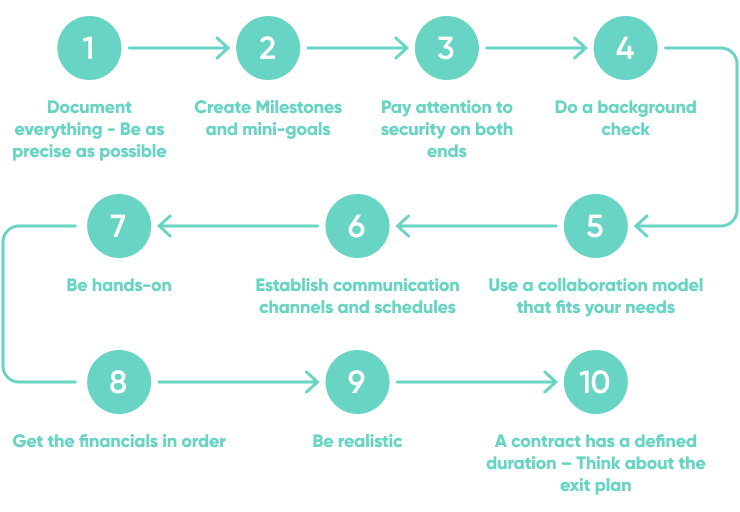Almost 30% of companies outsourced IT services, and 78% are satisfied.
Software development outsourcing can bring big benefits to your business, but there are significant risks and challenges when negotiating and managing outsourcing relationships.
Here, we present 10 outsourcing best practices you should adhere to when outsourcing software development.
- What is Outsourcing in Software Development?
- How To Start Outsourcing Software Development?
- 1. Document everything - Be as precise as possible
- 2. Create Milestones and mini-goals
- 3. Pay attention to security on both ends
- 4. Do a background check
- 5. Use a collaboration model that fits your needs
- 6. Establish communication channels and schedules
- 7. Be hands-on
- 8. Get the financials in order
- 9. Be realistic
- 10. A contract has a defined duration – Think about the exit plan
- Conclusion
What is Outsourcing in Software Development?
Software development outsourcing is the use of external resources to effectively implement software development projects.
There are three primary types of outsourcing models:
- Staff augmentation - you manage your projects development and leasing developers from the outsourcing provider.
- Managed team - you and external provider share responsibility and ownership of development project, agreeing on which responsibilities belong to whom.
- Project-based model - your outsourcing partner completes your projects based on your requirements, owning the projects from start to finish.
Choosing the right mode for you depends on your project and how much control you want to handle over to your external provider and your project.
Here is a table that can help you choose appropriate model:
| Staff augmentation | Managed team | Project-based | |
|---|---|---|---|
| Scope | Flexible | Flexible | Fixed |
| Timeline | Flexible | Flexible | Fixed |
| Project Management | Client | Outsorcing provider | Outsorcing provider |
| Overlap with In-House Team | High | Medium | Low |
To choose an outsourcing model, the fundamental question: How much flexibility do you require, and in what areas?
The different outsourcing models provide varying levels of flexibility in various areas (e.g., scope, timeline, overlap with in-house team).
The staff augmentation outsourcing model works best when have existing in-house development teams that you want to scale on-demand or fill a skill gap.
Often, clients have product visions that aren’t fully clear. Thats when managed team comes in handy with agility as to features, functionality, and prioritization.
A project-based model can be a good fit for you when you have fixed, well defined scope. The responsibility and processes are owned by your outsourcing partner.
How To Start Outsourcing Software Development?
So the question now becomes, where do you start outsourcing software development?
Here are a few tips to guide you along:

Document everything - Be as precise as possible
Whenever you’re collaborating with people outside your organization, it’s easy for miscommunication that can send a project off course. That’s why a Scope of Work (SOW) is such an important document for any project.
Remember, your list of criteria should match the specific characteristics of your project. This also includes accompanying tasks, duties and responsibilities to be fulfilled by the vendor.
Some such criteria will be very specific; however, do not expend extra energy on figuring out common traits. Instead, search for and utilize the lists compiled by others. Just modify them to fit the specifics of your project.
Create Milestones and mini-goals
One grave error companies fall victim to is thinking the job is as good as done when they hand over all the requirements to the development team. There are so many ways this can lead to catastrophic results.
Instead, certain milestones and mini-goals should be established for the total lifecycle of the project. This helps with keeping proper track of what has been achieved and what is still pending.

Also, the various milestones let you see the various functional parts of your application. This is important because an actual functional section might identify issues, possibilities and overall flow of the software development process. This also brings modularity to the project.
Pay attention to security on both ends
This part can not be overstated. When dealing with third-party providers, not only should you establish a secure means of transferring information on the project but a level of access control over the more sensitive data should be implemented on both sides.
It would be best to know what security measures and protocols the outsourcing firm has in place already and how they plan to handle your data. But security is a two-way stream, hence its also a good idea to establish secure means on how data is handled and transferred to the development team.
It should also be clearly stated in advance what can and can not be done with the information once it arrives in the possession of the outsourcing team. Usually, a good NDA(None Disclosure Agreement) should help with this.
Do a background check
The very first thing you would need to do when picking out your software development service provider is to have a shortlist of possible candidates. This helps in a few days, one of which is to establish a baseline of what the market cost is for such services. Once you know this you can move on to picking a list of those you feel would be a good fit for your project.
But this is only half the battle. The next part involves doing extensive research into the companies you have shortlisted. You need to know their strengths, average turnaround time and what previous clients had to say about them.
Do not forget you are entering into a relationship with a third-party, so its best to know if there are any skeletons in the closest to be wary of. It's easy to start a relationship but hard to extract yourself when things start going south.
Use a collaboration model that fits your needs
When we refer to models in this context we are talking about the payment structure established with the outsourcing team. These can take any of the following flavors:
- Hourly rates: Here the outsourcing team is paid a fixed rate every hour. For smaller software development projects this might be an idea since the lifecycle might be rather short if makes sense to pay for just the time spent on it. This also works when you have projects that require only slight modifications.
- Fixed rates: A fixed budget is arranged at the start of the product with clearly defined goals, scope, and durations.
- Dedicated: Usually used by large projects or companies that require the full attention of a dedicated team to work with. Such teams usually work on site.
Once you know the best model that fits your project scope, it's best to get the fine details worked out with the outsourcing team.
Establish communication channels and schedules
One of the greatest issues with using an outsourced team when developing custom applications is the lack of understanding between parties involved which in turn leads to delays and in some cases, unusable software. To forestall this, proper communication channels need to be created at the start of the project
The project score and deliverables should be clearly stated and explained. With both sides coming together and ensure that the full requirements and scope is understood by all.

Following this should be periodic scheduled updates on progress, issues, actionable and others. As long as there is a steady flow of information between both parties, it becomes easier to track where the project is at any point in time.
Be hands-on
When it comes to your project and it's software development, there is no such thing as too much information or allowing the outsourcing firm to have some space. Instead what should be happening is to have active participation in the development process.
You should not only be conversant with the current progress but make sure the outsourcing team uses tools and methodologies that keep you in the loop. A detached and hands-off approach can easily lead to misunderstanding and communication gaps that prolong the project's final delivery.
So it's always a good idea to make sure you understand the work culture and processes involved in hiring a software development outsourcing service from any given location.
Get the financials in order
Here we are talking about your budget. Even if there is a fixed budget for your project. It does not mean it is wise to go for the cheapest outsourcing company available. There has to be a balance between what you expect and what you are willing to pay for it. Once this is established the next step is to figure out what will be paid out and when.
If there are events that trigger payment, it should be clearly stated beforehand. It should be noted at this point that there is a very high possibility of going over the stipulated budget when outsourcing a project. Either due to unforeseen requirements or additions, or issues that crop up unexpectedly. Hence it's best to leave a little wiggle room in your budget for such occurrences.
Be realistic
Remember that you are dealing with humans, so a bit of flexibility is required. Hence realistic goals should be established. It is impractical to have a large software development project with multiple complex parts and give a short timeframe for completion. You end up with half baked or unusable software. Also, allocate time and resources for the unforeseen. It is better to have and not need than to need and be left wanting.
This does not mean you should be too lax with your goals and expectations. A bit of pressure goes a long way in attaining results. The trick is to know when and where to apply pressure to achieve the best results.
A contract has a defined duration – Think about the exit plan
It might seem counter-intuitive to have an exit plan at the start of an outsourcing contract but it is, in reality, an essential component of any outsourcing service contract.
The reality of the business environment is one that is in constant motion. What holds true today might not be so tomorrow. This is why an exit plan is needed at the start of the service. This way subject such as early termination, change in project scope and situation can be mapped and planned out by both parties if such an event is to occur.
Conclusion
It might take a while to get a good match right away, but finding the perfect software developer means that your business can grow and expand in ways that you haven’t thought of yet. The impact that this arrangement has on your business is rather profound, and as such, proper measures should be used to get it right.
Entering a partnership with a software development team isn't a simple task and should be considered an involved process. However, the above practical steps should go a long way towards seamless cooperation.







